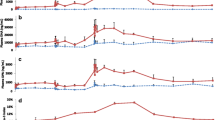Abstract
Peanut oil is unexpectedly atherogenic for rats, rabbits, and primates. The lesions it produces are more fibrous than fatty. The mechanism underlying the atherogenicity of peanut oil has been elusive. Randomization of peanut oil reduces significantly its atherogenic properties, but native and randomized peanut oils have similar rates of lipolysis, and rats fed the two oils absorb and transport lipids in a similar fashion. Peanut oil differs from other oils in having a relatively high lectin content, and the randomization process markedly reduces the lectin content as well. The biologically active lectin of peanut oil has an affinity for glycoproteins found specifically on arterial smooth muscle cells. Peanut lectin has been shown to stimulate growth of smooth muscle and pulmonary arterial cells. Vigorous washing of peanut oil reduces its lectin content by 46%. Compared to rabbits fed cholesterol and peanut oil, rabbits fed cholesterol and washed peanut oil exhibited less severe atherosclerosis in the aortic arch (by 9%) and in the thoracic aorta (by 31%). The data suggest that peanut oils' endogenous lectin may contribute significantly to its atherogenic properties.
Similar content being viewed by others
References
Gresham, G.A., and Howard, A.N. (1960) The Independent Production of Atherosclerosis and Thrombosis in the Rat. Br. J. Exp. Pathol. 41, 395–402.
Scott, R.F., Morrison, E.S., Thomas, W.A., Jones, R., and Nam, S.C. (1964) Short-Term Feeding of Unsaturated Versus Saturated Fat in the Production of Atherosclerosis in the Rat. Exp. Mol. Pathol. 3, 421–443.
Kritchevsky, D., Tepper, S.A., Vesselinovitch, D. and Wissler, R.W. (1971) Cholesterol Vehicle in Experimental Atherosclerosis. XI. Peanut Oil, Atherosclerosis 14, 53–64.
Vesselinovitch, D., Getz, G.S., Hughes, R.H., and Wissler, R.W. (1974) Atherosclerosis in the Rhesus Monkey Fed Three Food Fats, Atherosclerosis 20, 303–321.
Kritchevsky, D., Davidson, L.M., Weight, M., Kriek, N.P.J., and de Plessis, J.P. (1982) Influence of Native and Randomized Peanut Oil on Lipid Metabolism and Aortic Sudanophilia in Vervet Monkeys, Atherosclerosis 42, 53–58
Kritchevsky, D., Tepper, S.A., Kim, H.K., Story, J.A., Vesselinovitch, D., and Wissler, R.W. (1976) Experimental Atherosclerosis in Rabbits Fed Cholesterol-Free Diets. 5. Comparison of Peanut, Corn, Butter, and Coconut Oils, Exp. Mol. Pathol. 24, 375–391.
Steiner, A., and Dayton, S. (1956) Production of Hyperlipidemia and Early Atherosclerosis in Rabbits by a High Vegetable Fat Diet, Circ. Res. 4, 62–66.
Kritchevsky, D., Tepper, S.A., Vesselinovitch, D., and Wissler, R.W. (1973) Cholesterol Vehicle in Experimental Atherosclerosis. XIII. Randomized Peanut Oil, Atherosclerosis 17, 225–243.
Myher, J.J., Marai, L., Kuksis, A., and Kritchevsky, D. (1977) Acyglycerol Structure of Peanut Oils of Different Atherogenic Potentia, Lipids 12, 775–785.
Kritchevsky, D., Tepper, S.A., Kuksis, A., Eghtedary, K., and Klurfeld, D.M. (1995) Influence of Triglyceride Structure on Experimental Atherosclerosis, FASEB J. 9, A320.
Kim, H.K., and Kritchevsky, D. (1983) Lipolysis of Corn, Peanut and Randomized Peanut Oils, Lipids 18, 842–844.
Tso, P., Pinkston, G., Klurfeld, D., and Kritchevsky, D. (1984) The Absorption and Transport of Dietary Cholesterol in the Presence of Peanut Oil or Randomized Peanut Oil, Lipid 19, 11–16.
Satchithanandam, S., Weisenfeld, P., Flynn, T., Tashiro, Y., Calvert, R.J., and Kritchevsky, D. (1994) Absorption of Dietary Cholesterol and Oleic Acid in the Presence of Peanut Oil, FASEB J 8, A451.
Klurfeld, D.M., and Kritchevsky, D. (1987) Isolation and Quantitation of Lectins from Vegetable Oils, Lipids 22, 667–668.
Folch, J., Lees, M., and Sloane-Stanley, G.H. (1957) A Simple Method for the Isolation and Purification of Total Lipids from Animal Tissues, J. Biol. Chem. 226, 497–509.
Sperry, W.M., and Webb, M. (1950) A Revision of the Schoenheimer-Sperry Method for Cholesterol Determination. J. Biol. Chem. 187, 97–106.
Levy, A.L., and Keyloun, C. (1972) Measurement of Triglycerides Using Nonane Extraction and Colorimetry, Adv. Automated Anal. 1, 487–502.
Duff, G.L., and McMillan, G.C. (1949) The Effect of Alloxan Diabetes on Experimental Cholesterol Atheroslerosis in the Rabbit. J. Exp. Med. 89, 611–630.
Lotan, R., Skutelsky, E., Danon, D., and Sharon, N. (1975) The Purification, Composition and Specificity of the Anti-T Lectin from Peanut (Arachis hypogaea), J. Biol. Chem. 250, 8518–8523.
Weber, K., and Osborne, M. (1969) The Reliability of Molecular Weight Determinations by Dodecyl Sulfate-Polyacrylamide Gel Electrophoresis. J. Biol. Chem. 244, 4406–4412.
Sanford, G.L., and Harris-Hooker, S. (1990) Stimulation of Vascular Cell Proliferation by Beta-Galactosidase Specific Lectins, FASEB J. 4, 2912–2918.
Banerjee, R., Das, K., Ravishankar, R., Suguna, K., Gurolea, A., and Vijayan, M. (1996) Conformation, Protein-Carbohydrate Interactions and a Novel Subunit Association in the Refined Structure of a Peanut Lectin-Lactose Complex. J. Mol. Biol. 259, 281–296.
Author information
Authors and Affiliations
Corresponding author
About this article
Cite this article
Kritchevsky, D., Tepper, A. & Klurfeld, D.M. Lectin may contribute to the atherogenicity of peanut oil. Lipids 33, 821–823 (1998). https://doi.org/10.1007/s11745-998-0276-9
Received:
Revised:
Accepted:
Issue Date:
DOI: https://doi.org/10.1007/s11745-998-0276-9



